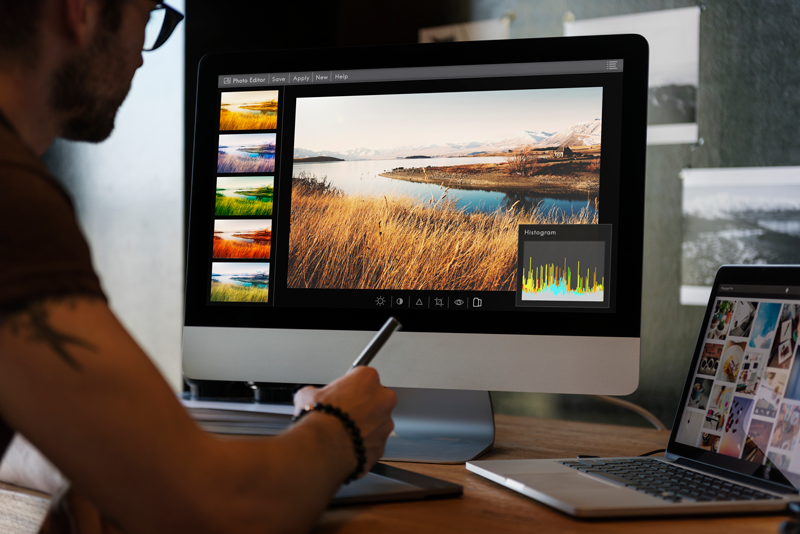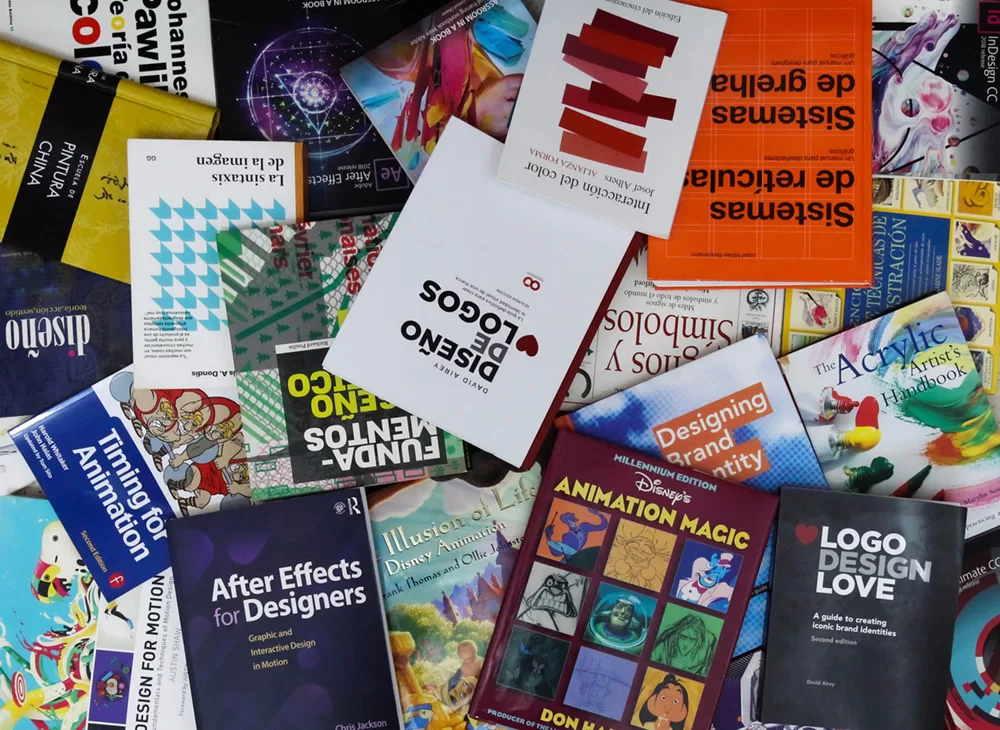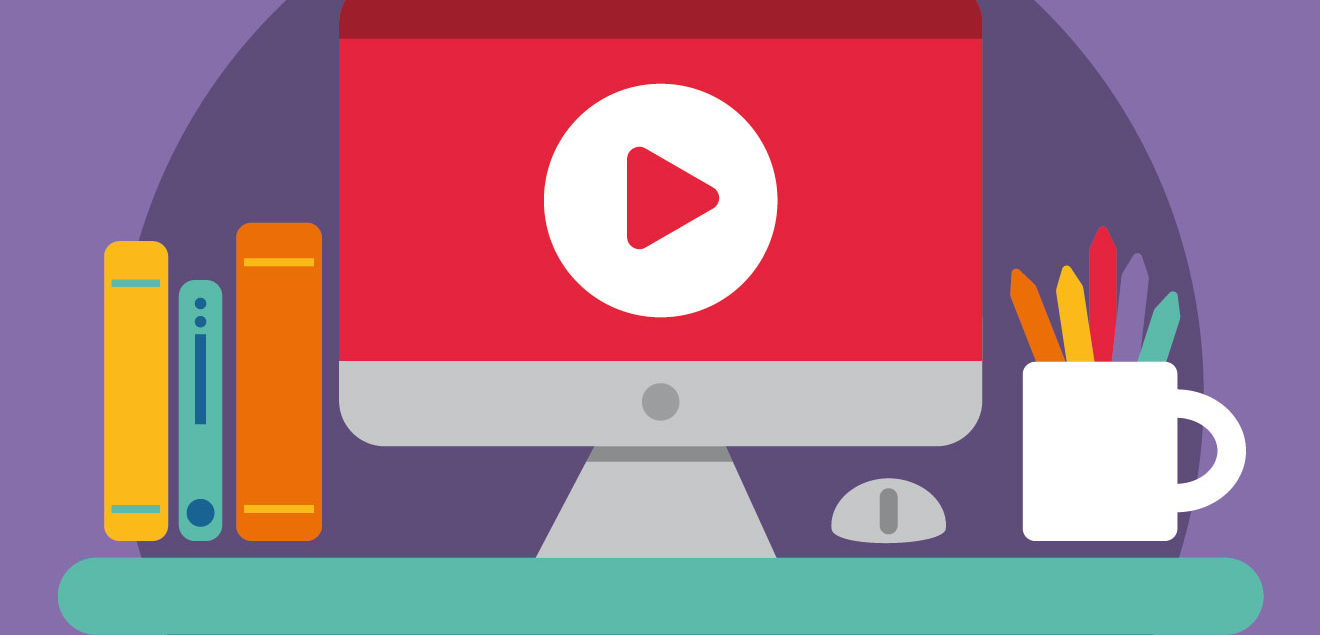Where and how do Graphic Designers work?
Last Updated on June 30, 2024 by Ilka Perea Hernández
The range of action of graphic designers is as wide as the different needs they supply. In order to know where and how graphic designers work, it is important to understand the demands of the labor market and the expectations about their performance.

Graphic designers work in many companies, institutions, and agencies, where they create several design products: advertising, digital publishing, illustration, branding, corporate identity, exhibition design, interface design, package design, and web design. On the other hand, some self-employed designers work for clients or on their products.
If you are a graphic design student or are already a professional in the field, you will be interested in knowing the options you have to develop your career in the labor field. Whether you prefer to be an employee or a self-employed designer, both options have their pros and cons that you should know to choose wisely.
In this post, I will explain some of the skills and roles required in the job field in order to let you know the scope, standards, and expectations that the job market has for graphic designers.
Table of Content
- Aptitudes of Graphic Designers
- What are the skills and abilities of Graphic Designers?
- Hard Skills
- Soft Skills
- Duties of Graphic Designers
- What are the responsibilities of Graphic Designers?
- Roles of Graphic Designers
- What are the positions or functions of Graphic Designers?
- Work Area of Graphic Designers
- How do employed and self-employed graphic designers work?
- Working as an in-house graphic designer
- In-house graphic designer advantages
- In-house graphic designer disadvantages
- Working as a graphic designer for an agency
- Agency Advantage
- Agency Disadvantage
- Working as a freelance graphic designer
- Freelance graphic designer advantages
- Freelance graphic designers disadvantages
- Working as a solopreneur graphic designer
- Solopreneur graphic designer advantages
- Solopreneur graphic designers disadvantages
- Summary
- Some Insights
- Trends in the Labor Market
- Internships — Getting experience
- Build an Outstanding Portfolio
- Any Thought?
- Cite this post
Aptitudes of Graphic Designers

What are the skills and abilities of Graphic Designers?
Every graphic designer must have a solid theoretical base in subjects such as visual communication concepts, such as images and symbols, grid systems, the use of typography, and color theory. In addition, they should know how to communicate their ideas and be able to work in a team.
All the above means that employers are looking for certain skills in graphic designers. These include hard skills and soft skills; the last one can be difficult to quantify and reflect on (how one interacts with others and their environment).
Hard Skills
Hard skills are often the first skills that HR recruiters look for. Some of them are:
- Technical skills: it is essential to master the use of typography, color theory, grids, and color profiles, among other graphic design concepts.
- Artistic skills: Graphic designers must be able to create designs that are artistically interesting and attractive to clients and consumers. They produce sketches, illustrations, and comics either by hand drawing or using a computer program.
- Computer skills: Most graphic designers use specialized graphic design software to prepare their designs.
Soft Skills
If hard skills are our best cover letter and give us access to jobs, soft skills allow us to stay in them.
- Communication skills: they must be able to give advice and suggestions to clients. Graphic designers must communicate with clients and other designers to ensure that their designs accurately reflect the desired message and effectively express the information.
- Time management skills: they will often find that they are juggling several projects simultaneously, each with a different deadline. Consequently, designers must be able to work methodically to meet deadlines.
- Teamwork skills: designers must be able to collaborate and have a good relationship with others when working as part of a design team.
- Analytical skills: Graphic designers must be able to see their work from the point of view of their consumers and examine how consumers will perceive the designs they develop to ensure they convey the client’s desired message.
- Creativity: Graphic designers must be able to think of innovative approaches to communicate ideas to consumers. They develop unique designs that convey recognizable meaning with persuasive visual impact.
Duties of Graphic Designers

What are the responsibilities of Graphic Designers?
Graphic designers are visual communicators who convey ideas to inspire, inform, or engage viewers through physical and digital media forms that include images, words, or graphics. Besides, graphic designers often collaborate on projects with artists, multimedia animators, and other creative professionals.
Depending on the area of design, the duties of the graphic designer would be:
- Meet with clients or the art director to determine the scope of a project.
- Analyze design briefs and determine requirements. In other words, the designer must schedule the projects and define some budget restrictions.
- Advise clients on strategies to reach a particular audience. In other words, the designer should attend meetings with clients to understand how they want their communications proposals to look and incorporate illustrations, images, and text to reflect the desired theme and tone of communications.
- Determine the message that the design should represent. For example, the designer creates images that identify the product or convey the previously specified message.
- Create materials by hand or using technology, including computer-aided design. Adobe Creative Suite, which includes Photoshop, Illustrator, InDesign, and others, is the industry standard, and most employers expect designers to master these programs.
- Produce drafts for client review and make changes based on comments received.
- Review final productions for errors and ensure that final prints reflect client specifications. Therefore, the designer must incorporate the changes recommended by clients into the final design. In addition to ensuring that the final graphics and designs are visually appealing and meet the pre-set requirements.
Roles of Graphic Designers

What are the positions or functions of Graphic Designers?
- Creative Director: manages a creative team that creates images for product branding, advertising campaigns, etc.
- Art Director: manages and coordinates between production artists and illustrators to ensure projects are completed on time and to the client’s satisfaction.
- Art Production Manager: manages the production aspect of art generation and creation, with a focus on improving efficiency and reducing costs.
- Packaging Designer: creates and designs packaging for marketing and/or products in terms of design and physical construction.
- Brand Identity Developer: develops brand identities for various organizations.
- Visual Image Developer: can create images and designs through 3D modeling, photography, and image editing.
- Broadcast Designer: creates visual designs and electronic media for use in television productions.
- Interface Designer: develops graphical user interfaces and usually works for web development companies.
- Web Designer: creates graphics, layouts, and pages for websites.
- Multimedia Developer: applies graphic design skills to sound and/or motion.
Work Area of Graphic Designers

How do employed and self-employed graphic designers work?
Graphic designers often work as employees in institutions or companies with access to drawing boards, computers, and the software necessary to develop design projects. While many of them work independently as self-employed designers, those who work for specialized agencies are often part of a design team. Many graphic designers partner with colleagues on projects or collaborate with clients in face-to-face, remote, or hybrid work models. In short, graphic designers work in different work environments with different working models. Therefore, the answer to this question depends on which option is chosen.
Working as an in-house graphic designer
Working in-house means that you are employed by an established organization, and your work is focused on a single brand or a particular group of related brands. The main goal of graphic designers is to make them recognizable and prominent among organizations that hire them. Through several media, they communicate a particular idea or identity for use in advertising and marketing campaigns. Graphic designers in these types of roles tend to be generic. They possess a wide range of general design skills to meet all the company’s creative needs. Most graphic designers work full-time, but schedules may vary depending on workloads and deadlines.

In-house graphic designer advantages
- Opportunities for advancement: potential for promotion in the corporate career.
- Benefits of a traditional work environment: separation of home and work; collaboration with colleagues in a social workplace; company benefits.
- A brand or set of brands to develop: the unique approach allows designers to develop a deep understanding of the organization’s brand, style, and target audience; the opportunity to build a long-term strategy and see the results it produces.
- A steady wage: financial stability without having to build up a client base.
In-house graphic designer disadvantages
- More rules: an established business brand may seem restrictive; it requires you to produce innovative ideas while adhering to the brand’s guidelines.
- More communication: you may need to explain and justify your designs to non-designers.
- An environment without design: office space may not be optimized with designers in mind; there will be fewer, if any, design colleagues to collaborate with.
Working as a graphic designer for an agency
External clients hire agencies to produce creative projects. In this environment, graphic designers often work with a variety of brands. Tasks tend to be short-term, project-based, and limited to a specific campaign. Beginning graphic designers usually need 1-3 years of work experience before they can advance to higher positions. Experienced graphic designers can advance to chief designer, art director, creative director, or other supervisory positions.

Agency Advantage
- The expectation of design excellence: managers and co-workers who are designers and/or familiar with the design world; high expectations of professionalism; numerous opportunities to advance their design skills; some fewer communication delays than can occur when collaborating with non-designers.
- Established processes and mentors: Agencies tend to streamline their processes and systems, as well as senior designers from staff, which creates productive learning environments for new designers.
- Focus on graphic design: non-design tasks are extremely rare; daily work is always within the scope of graphic design.
Agency Disadvantage
- Less job security: agencies hire staff to match the contracts they have. If the project list falls, there is a risk of dismissal due to the need to reduce the number of graphic designers.
- Rigorous hours: The agency setup is fast, with tight deadlines. The phrase “turning over the clock” is frequent in this work environment because it is essential to finish a project.
Working as a freelance graphic designer
Freelance graphic designers are responsible for much more than graphic design projects. As self-employed graphic designers, they are in charge of doing the accounting (paying providers and billing clients) as well as marketing and advertising themselves. They must adjust their work schedules to meet with clients in the evenings or on weekends. In addition, they may spend some of their time looking for new projects or competing with other designers for contracts. They must be their assistants, keeping track of deadlines and transporting themselves to make deliveries for physical projects. This work condition demands considerable self-discipline and commitment.

Freelance graphic designer advantages
- Location: no travel; flexibility to work from anywhere with Wi-Fi.
- Creative freedom: creative flexibility; select a job that challenges and inspires you.
- A personalized schedule: Adapt your hours to the lifestyle you want if you keep up the pace and remain productive.
Freelance graphic designers disadvantages
- No co-workers: Essentially, you will work alone in relative isolation, in an uncooperative environment, which can sometimes challenge your motivation.
- Job search and offer: projects won’t land on your desk; you’ll have to actively seek out, and sometimes compete to win, projects.
- Unreliable pay without benefits: pay can vary dramatically from month to month, depending on the workflow; health insurance, parental leave, and retirement accounts will be your responsibility.
- Operating costs: You must assume the costs of the operation. For instance, you will pay for software licenses, equipment repair, maintenance, and electricity bills.
Working as a solopreneur graphic designer
Solopreneurs are graphic designers who work on their own design projects. They are generally self-driven and have a high degree of autonomy, allowing for flexibility in work schedules and creative processes. Solopreneurs can quickly adapt to industry trends and changes, making them agile in responding to customer preferences. Being a solopreneur designer demands a broad skill set, which can sometimes lead to burnout.

Solopreneur graphic designer advantages
- Flexibility: Solopreneurs have the freedom to set their own schedules and choose projects aligned with their interests.
- Direct Client Relationships: Building direct relationships with clients can lead to better communication and a deeper understanding of their vision.
- Creative Control: Solopreneurs have complete control over their creative process and final output, allowing for a distinctly personal touch.
Solopreneur graphic designers disadvantages
- Isolation: Working alone can lead to feelings of isolation, limiting opportunities for collaboration and creative exchange.
- Limited Resources: Solopreneurs may face resource constraints, such as limited time and budget for professional development or marketing efforts.
- Work-Life Balance Challenges: Juggling multiple roles can make it challenging to maintain a healthy work-life balance.
Summary
- To comprehend the working conditions and practices of graphic designers, it is crucial to have insights into the requirements of the job market and the anticipated standards for their professional contributions.
- A graphic designer must have some hard skills, such as technical and artistic, and some soft skills, such as communication and analytical.
- Some roles that graphic designers could play are creative director, art director, art production manager, packaging designer, brand identity developer, visual image developer, broadcast designer, interface designer, web designer, and multimedia developer.
- Freelancers and solopreneurs are graphic designers who work as self-employed, performing a variety of tasks in addition to developing design projects.
- Some graphic designers work as employees in companies and agencies with certain job guarantees.
Some Insights
To understand the working conditions and practices of graphic designers, it is necessary to know the criteria of the labor market and the standards expected of their professional contributions. The demand for graphic and digital designers has changed in recent years, especially after the COVID-19 pandemic in 2020 and the economic crisis generated by confinement.
Trends in the Labor Market
Generally speaking, the work model was on-site, and the standard was to be hired on a long-term basis by a private company or a creative agency. However, the entire world has had to adapt to drastic changes since the pandemic. Many industries shifted to a model of working from in-person to remote. This opened a new perspective. Many managers and employers realized that there was no need to hire on-site staff and that it was possible to manage projects by outsourcing services.
Currently, businesses and agencies are recruiting more designers as freelancers than employees. From my point of view, this trend will increase. Even more so with the explosion of apps based on artificial intelligence (AI).
Soft skills will probably gain more relevance than hard skills. I mean that being able to communicate effectively with others, possessing critical and analytical thinking, and developing creative projects will be much more appreciated skills than hard skills that can be learned by AI.
Whether you prefer to be employed or self-employed, you must develop a strategy to be considered in the face of intense competition in the labor market.
Internships — Getting experience
Don’t wait until you finish your studies to gain work experience. I recommend getting some experience during the years of study—a valuable attribute for HR recruiters. Hands-on classroom projects, graphic design internships, and freelance work for family and friends are good opportunities to acquire knowledge and experience.
Internships help to bridge the knowledge gap between formal graphic design studies and the proficiency required in the workplace. These help you gain confidence in your skills, and if you discover that you need others, you will know which ones to learn or strengthen.
Build an Outstanding Portfolio
It’s Showtime! The portfolio is a collection of the best designs or projects made by the designer. Think of a portfolio as a showcase. You don’t show everything, but you show the best of the best to catch the interest of HR recruiters or a prospective client.
I suggest doing an annual review to add the latest works and get rid of those that do not represent your potential. The portfolios can be physical (printed) or digital (online). I highly recommend Behance to show your best projects online.
Any Thought?
In the comments section, tell me which of the options you find most exciting: working in-house, in an agency, as a freelancer, or as a solopreneur. Have you already had experience as a designer in one of these areas? What would you recommend to other designers?
Cite this post
- APA Style:
Perea Hernandez, I. (2018, January 11). Where and How Do Graphic Designers Work? Retrieved from https://ilkaperea.com/2018/01/11/where-and-how-do-graphic-designers-work/ - Chicago Style:
Perea Hernandez, Ilka. 2018. “Where and How Do Graphic Designers Work?” January 11. Accessed [insert date accessed]. https://ilkaperea.com/2018/01/11/where-and-how-do-graphic-designers-work/. - MLA Style:
Perea Hernandez, Ilka. “Where and How Do Graphic Designers Work?” Ilka Perea, 11 Jan. 2018, ilkakperea.com/2018/01/11/where-and-how-do-graphic-designers-work/. Accessed [insert date accessed]. - Harvard Style:
Perea Hernandez, I. (2018) Where and How Do Graphic Designers Work? [online] Available at: https://ilkaperea.com/2018/01/11/where-and-how-do-graphic-designers-work/ (Accessed [insert date accessed]).

Share
Spread the love… and this post!
If you liked it, share this post on your social networks. Smart designers share good things with others.

Bibliography
- Cezzar, J. (2017). The AIGA Guide to Careers in Graphic and Communication Design. Bloomsbury Academic.
- Gómez-Palacio, B.; Vit, A. (2011). Graphic Design Referenced: A Visual Guide to the Language, Applications, and History of Graphic Design. Rockport Publishers.
- Heller, S.; Vienne, V. (2015). Becoming a Graphic and Digital Designer: A Guide to Careers in Design. (5th ed.) Wiley.
- Janda, M. C. (2019). The Psychology of Graphic Design Pricing: Price creative work with confidence. Win more bids. Make more money. Independently Published.
- Poulin, R. (2018). The Language of Graphic Design Revised and Updated: An illustrated handbook for understanding fundamental design principles. Rockport Publishers.

